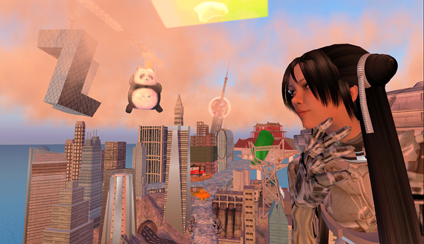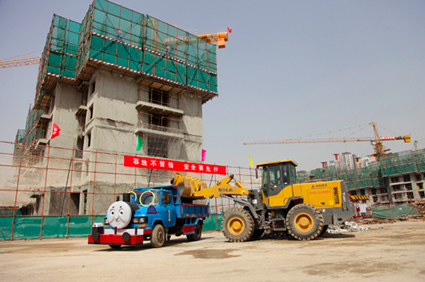teasing consumerism
christen cornell: profile, artist cao fei

Cao Fei, China Tracey, RMB City, 2009
FROM CAO FEI’S ENTRE TO THE ART WORLD IN THE LATE 1990S SHE WAS PITCHED AS “NEW GENERATION”—A REPRESENTATIVE OF THE MUCH NEEDED NEXT WAVE OF ARTISTS TO CARRY ON FROM THE THEORETICAL DILEMMAS (AND HYPE) GENERATED AROUND THE CONTEMPORARY CHINESE ARTISTS WHO HAD PRECEDED HER. DRAWING ON THE LANGUAGES OF POP AND YOUTH CULTURES, SHE SIGNIFIED A NEW VOICE ON CHINESE SOCIETY, ONE THAT WAS SAVVY WITH GLOBALISATION AND COULD COMMENT ON CHINESE CONSUMERISM WITH THE TOOLS OF THE SYSTEM ITSELF.
More than 10 years on, Cao Fei is astoundingly accomplished, having spent the greater part of her 20s engaged in elaborate experiments with multimedia, collaborative performance pieces and deep explorations into the world of virtual reality. While primarily a video artist, Cao Fei’s interest in theatre has extended her work to the stage, often toying with the distinction between the digital and the real. Films inspired by the cultures of hip hop, pornography and gaming have given verve to her artistic vocabulary; meanwhile her cool eye is manifest in a number of shrewd documentaries. Cao’s works have been included in biennales around the world and dozens of catalogues and compendiums include essays under her name.
Is Cao Fei still next generation then? When asked, she raises her eyebrows sarcastically and, with characteristic minimalism, points to the eight-months pregnant belly before her (she also has a two-year-old son). “You’d still call me a young artist?” Whatever the relevance of such categories, however, Cao’s work maintains the same exuberance that first attracted the label of youth—the vivid colours of popular media and a preoccupation with fantasy.
at play with commercial culture

Cao Fei, East Wind (2011)
In Cao Fei’s most recent video work, East Wind (2011), a dinky blue Chinese truck with the face of Thomas the Tank Engine beetles around the streets of a Chinese city to the theme tune of the BBC program. The truck stops for petrol, attracting a crowd of delighted fans. It collects rubbish from a demolition site and then merrily takes this to a dump on the outskirts of town (the driver stopping for a pee by the side of the road on the way). With a sense of joyful conquest, the bright smiling face of Thomas charges through the changing Chinese landscape, announcing the triumph of simplicity at every turn.
“When I had my son, I came into contact with all these new DVDs. They gave me this new kind of feeling of innocence,” says Cao Fei. “You can learn a lot about the adult world through children’s culture,” she adds. As is common in Cao’s works, however, the spirit of innocence in East Wind belies the film’s sophistication. Using a nationally manufactured truck for this naively made Thomas (a truck developed by Mao in the 1950s and named East Wind with reference to the proverb “the East Wind will prevail over the West Wind”) and adding its own synthesised version of the theme song, the film is as much about Chinese appropriation of Western culture as it is about Western hegemony.
Raised in the country’s South, on a diet of MTV, foreign films and Hong Kong comedy, Cao has a droll kind of ease with the global commercialisation of culture: “Our generation of Chinese artists, those born in the 1970s, grew up after the Cultural Revolution so it didn’t really influence us that much. Of course our parents gave us a sense of that time, but the larger influences came from the 1980s—when Western culture came to China.” Curious rather than anxious about questions of authenticity, her art takes a playful approach, deploying these same images of commercial culture for its nimble social critiques.
a second life china
The activities which have most defined Cao Fei’s reputation to this point are those associated with her RMB City project—a highly ambitious and multi-faceted venture into the online world of Second Life. Beginning in 2007, with Cao’s creation of an avatar called China Tracy, the project quickly spiralled out into more than a dozen artworks and events, each one an experiment with popular media and a consideration of its power as a means of escape. The framework for all this was the RMB metropolis, built within virtual reality. A bubble-like
topography of Chinese landmarks and inflated pandas, RMB City was a vision of an aspirational China—”a city at the top of the economy”—named after the Chinese currency and dizzy with its own possibility.
With land for sale, and subjects needed, RMB City rapidly evolved into a collaboration with the contemporary Chinese art world. Prominent collectors such as Uli Sigg and the Ullens Centre for Contemporary Art purchased buildings and were accordingly given positions as mayors. Curators and fellow artists took on Second Life avatars and engaged with the project as citizens. A virtual Yokohama Triennale was even held in the city’s streets (a dancing, slightly drunken version), resulting in the film Play with Your Triennale (2008) which was shown later at the actual festival. As the city developed, its pumped up colours, youthful avatars and illusions of confidence came to suggest not only the hyper-reality of contemporary Beijing, or even global consumerism, but the international art world itself.
“It was a bit like a residency,” says Cao, referring to the role played by her investors and collaborators. “You could do a two- year residency in virtual space. And if you asked me what aspect I’m most proud of in RMB it would be the fact that it combined so many elements and people.” Accompanied by a range of press materials and merchandise—from stickers to newsletters to advertisements—RMB City became a major, almost orchestral, production. When asked about this penchant for theatrics, Cao points to her earliest film and documentary projects, and even beyond that to her years at school. “New media came later, along with the internet. But my first interest I’d say was performance.”
Cao and her gallery, Vitamin Space, are now looking to hand RMB over to new caretakers, ideally a university or research institute. “Students could use it, or people with the right kind of specialty,” she says. “This way we wouldn’t have to ‘delete’ it. It could continue as something alive.”
fantasy & melancholy
Not all of Cao Fei’s art is so colourful. Some of her best-known films are comparatively gritty, depicting China’s economic development with images conveying the reality. Even these works however are leavened with the effects of pop culture, the private desires that keep people going, or an editing that gives life to industrial machinery. Cao’s interest in China’s development appears to be largely in the aspirations that keep it churning and the melancholy that is the flip side of fantasy.
“Perhaps there is something in me which just can’t grow up,” she says. “The humour in my art—it might be a social critique, or a national critique, but it’s not so direct. It’s closer to daily life. It praises life and shows how people in all kinds of situations can find the happiness they need to live on.” Good-humoured more than ideological, Cao’s work often bristles with mischief and can brighten you on a bad day. It doesn’t challenge the consumer system so much as tease it gently (and articulately) from within. Perhaps Cao Fei could try an Annie Leibovitz move and do a strange Walt Disney commercial on the side. Her work is already a collaboration with various dream factories—a voyage of pop utopias conducted in the languages of illusion.
RealTime issue #105 Oct-Nov 2011 pg. 44






